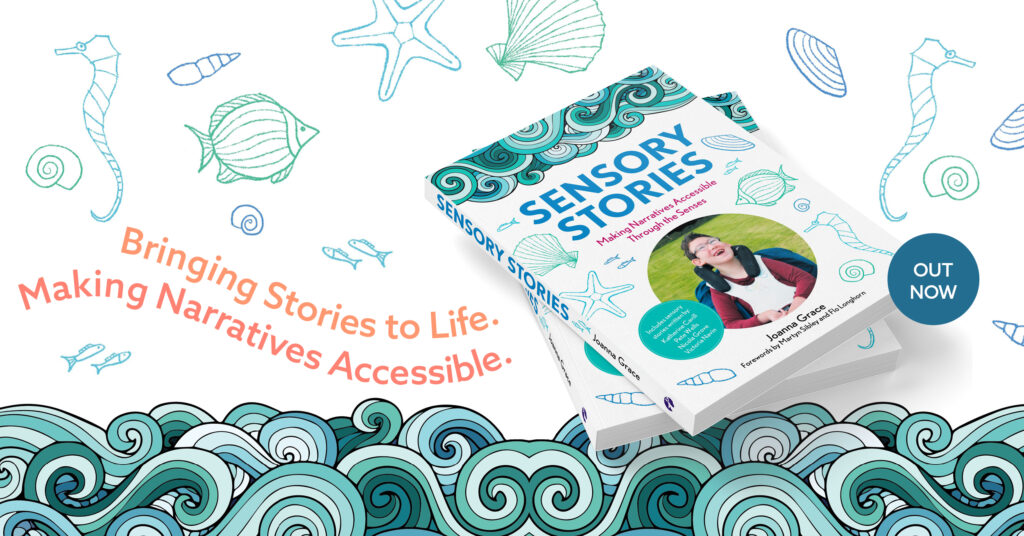
International sensory engagement and inclusion specialist and author Joanna Grace, shares with us the magic of sensory stories for people of all ages, and tells us which of the stories in her new, updated edition of Sensory Stories: Making Narratives Accessible Through the Senses she’s most excited about.
Sensory stories have long been a hidden gem in the world of special education, but it is a gem that is hidden no longer! In the decade since the publication of the first edition of Sensory Stories, I’ve had the pleasure of sharing sensory stories with children in mainstream education, I’ve shared them with university students, with parent and baby groups, with people with later stage dementia and learning disabilities. I am sensory stories number one fan, their simplicity and their invitation to connect with the world around you make them a wonderful creative, inclusive tool.
In writing them of course I find myself in some strange situations. All my stories are resourced with everyday items, or very inexpensive things like a small torch, or some rice. I often think if you’re claiming to be inclusive, but you are using something someone else cannot afford, then how inclusive are you really being? So, in crafting the stories, and seeking out really great sensory experiences to accompany the sentences within them, I can be found wondering around my kitchen trying to find the smell of a certain character, or running my fingers over the various washing up brushes in the supermarket looking for the feel of another character’s bristles.
Readers of this book will not be thrust into those situations (at first), as it contains 9 sensory stories and activities to go with them and tells you how to resource them, you do not need to wonder what on earth would smell like that, or what would make the sound of that particular character, as it is already in there. However, I do warn you, you are likely to find yourself in those situations before too long, as once you begin sharing sensory stories, it is hard to stop and creating your own is so worthwhile and so much fun. It won’t be long before you’re standing in the garden touching the grass and the branches searching for a particular sensation, or you are getting funny looks in the supermarket as you carefully sniff each of the soaps for the perfect scent. The book gives you all the insight you need into the science behind the stories to enable you to confidently create your own and it gives guidance on how to share them with a diverse range of people so that once you have a story in your hands you can truly maximise its impact.
The wonderful thing about going on these sensory adventures and sensory quests is that it invites us into a connection with our present, it is like a little piece of mindfulness in motion, so yes, the stories are great for the people you might be thinking of sharing them with: they’re accessible for people who do not use words, so you can share them with people with profound disabilities, people with dementia, tiny little babies, they’ve so much value for people who experience the world in a sensorially different way, this could be due to a sensory impairment or due to sensory processing differences, but they are also great for you, they’re good for your mental health as they call you into a playful connection with the present.
I’ve now been sharing sensory stories for over two decades and my love of them has not waned, it has only grown. One of the things I am most excited about as I see the publication of this second edition of the book is the guest stories, from authors other than me, Victoria Navin has provided a great rhyming story about getting a haircut, Dr Nicola Grove brings us a traditional Zulu story, Pete Wells has a superhero story full of mischief and fun, and then the story that I am most excited about, more than the guest author stories, more than the five stories of my own in there, is the story that ends the book…
With most artforms you expect that in time their consumers become their creators. Sensory stories were originally conceived of as a way of sharing narrative with people with profound intellectual and multiple disabilities. People who many would consider not to be capable of writing a story. In this book their time has come. The final story of the book was authored by over sixty people with profound intellectual and multiple disabilities who attend the National Star College, witnessing its authoring was easily one of the best days of my life, and getting to share that story with you through the pages of this second edition is an utter joy!
Sensory Stories: Making Narratives Accessible Through the Senses by Joanna Grace is available now.
If you liked this article, why not join our mailing list to receive exclusive content and discounts? Sign up to the mailing list here.